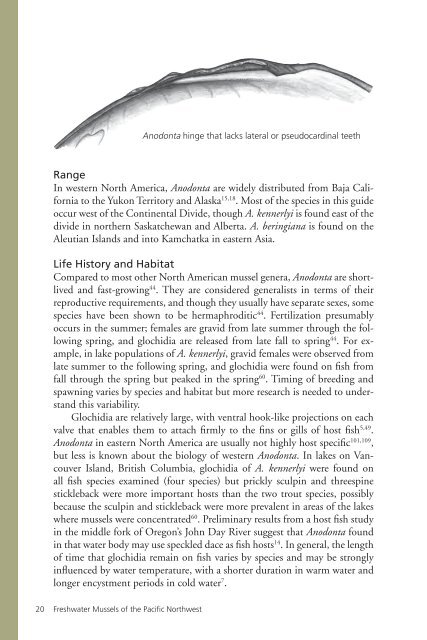Freshwater Mussels Pacific Northwest - The Xerces Society
Freshwater Mussels Pacific Northwest - The Xerces Society
Freshwater Mussels Pacific Northwest - The Xerces Society
You also want an ePaper? Increase the reach of your titles
YUMPU automatically turns print PDFs into web optimized ePapers that Google loves.
20<br />
Anodonta hinge that lacks lateral or pseudocardinal teeth<br />
Range<br />
In western North America, Anodonta are widely distributed from Baja California<br />
to the Yukon Territory and Alaska 15,18 . Most of the species in this guide<br />
occur west of the Continental Divide, though A. kennerlyi is found east of the<br />
divide in northern Saskatchewan and Alberta. A. beringiana is found on the<br />
Aleutian Islands and into Kamchatka in eastern Asia.<br />
Life History and Habitat<br />
Compared to most other North American mussel genera, Anodonta are shortlived<br />
and fast-growing 44 . <strong>The</strong>y are considered generalists in terms of their<br />
reproductive requirements, and though they usually have separate sexes, some<br />
species have been shown to be hermaphroditic 44 . Fertilization presumably<br />
occurs in the summer; females are gravid from late summer through the following<br />
spring, and glochidia are released from late fall to spring 44 . For example,<br />
in lake populations of A. kennerlyi, gravid females were observed from<br />
late summer to the following spring, and glochidia were found on fish from<br />
fall through the spring but peaked in the spring 60 . Timing of breeding and<br />
spawning varies by species and habitat but more research is needed to understand<br />
this variability.<br />
Glochidia are relatively large, with ventral hook-like projections on each<br />
valve that enables them to attach firmly to the fins or gills of host fish 5,49 .<br />
Anodonta in eastern North America are usually not highly host specific 101,109 ,<br />
but less is known about the biology of western Anodonta. In lakes on Vancouver<br />
Island, British Columbia, glochidia of A. kennerlyi were found on<br />
all fish species examined (four species) but prickly sculpin and threespine<br />
stickleback were more important hosts than the two trout species, possibly<br />
because the sculpin and stickleback were more prevalent in areas of the lakes<br />
where mussels were concentrated 60 . Preliminary results from a host fish study<br />
in the middle fork of Oregon’s John Day River suggest that Anodonta found<br />
in that water body may use speckled dace as fish hosts 14 . In general, the length<br />
of time that glochidia remain on fish varies by species and may be strongly<br />
influenced by water temperature, with a shorter duration in warm water and<br />
longer encystment periods in cold water 7 .<br />
<strong>Freshwater</strong> <strong>Mussels</strong> of the <strong>Pacific</strong> <strong>Northwest</strong>

















